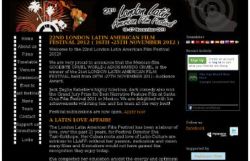The 22nd London Latin American Film Festival runs from 16th to 25th November 2012. Its founder and Director, Cuban film-maker Eva Tarr-Kirkhope, spoke to LAB about the origins and development of this festival.
 The London Latin American Film Festival was conceived by Eva, a Cuban filmmaker, as a reaction to being unable to watch Latin American films in London. Up until that point it had been necessary to travel to Paris or Madrid to watch Latin American films or to purchase books written in Spanish. Her husband owned the independent Metro Cinema in the West End and it was there they put on the first festival in 1990. This first festival comprised feature films from established Latin American filmmakers, and included Morir en el Golfo (Mexico), La Bella del Alhambra (Cuba), Días Difíciles (Mexico), Últimas imágenes del naufragio (Argentina), Hombre mirando al sud-este (Argentina), El amor es una mujer gorda (Argentina), Boda Secreta (Argentina), La última cena (Cuba), and A Dama do Cine Shanghai (Brazil), among many others.
The London Latin American Film Festival was conceived by Eva, a Cuban filmmaker, as a reaction to being unable to watch Latin American films in London. Up until that point it had been necessary to travel to Paris or Madrid to watch Latin American films or to purchase books written in Spanish. Her husband owned the independent Metro Cinema in the West End and it was there they put on the first festival in 1990. This first festival comprised feature films from established Latin American filmmakers, and included Morir en el Golfo (Mexico), La Bella del Alhambra (Cuba), Días Difíciles (Mexico), Últimas imágenes del naufragio (Argentina), Hombre mirando al sud-este (Argentina), El amor es una mujer gorda (Argentina), Boda Secreta (Argentina), La última cena (Cuba), and A Dama do Cine Shanghai (Brazil), among many others.
Originally, the Festival showed only feature films by well-known and established names in the industry. There was widespread support from the media, including the BBC, C4 and the British Institute and the festival was extremely well financed. By contrast, today the festival has no funding at all and Eva must finance it singlehandedly. Since the economic crisis, funding for the Arts has suffered considerably and the government appears to be no longer interested in culture or education. In the absence of direct funding, the Festival survives by using mutual publicity exchange with other organisations and by using social networking, such as Twitter and Facebook. Adverts in print media such as Time Out are no longer affordable.
An important priority for the Festival is to show films from as many Latin American countries as possible. It was proud to show the first Paraguayan film to be seen in the UK, and has also screened ‘firsts’ from Haiti, Snato Domingo and Jamaica.. In the last 15 years the Festival has featured films from Bolivia, Ecuador, Costa Rica, Guatemala, Nicaragua, and Caribbean islands such as Jamaica and Haiti.
This year, as always, Eva will feature new and interesting filmmakers from the region as part of her policy of discovering and fostering young talent from Latin America. The diversity extends to films made by or about women, disabled people, the gay community and senior citizens. This year, there is a special emphasis on the representation of childhood, the problem of violence, drug and human trafficking. According to Eva, daily life should be shown on cinema screens, because cinema is a reflection of reality, no matter how gritty or far from the Hollywood ideal.
One of the successes of the Festivals has been improvements in the distribution of Latin American films in the UK. Latin American films typically have only the shortest of runs in UK cinemas. For example recently “Siete días en la Habana” was only shown for a week in certain cinemas. Every year, at least one of the films from the festival is released for distribution, such as “Hijos de Cuba” in 2009 and “Chico y Rita” the following year.
Films entered for the festival are not restricted to filmmakers living in Latin America, or even to Latin Americans themselves. For example, “Hijos de Cuba” was made by Andrew Lang, an Englishman, but the subject matter was about Latin America so it qualified for the festival. Many of the entries come from Latin Americans based in Europe or from non-Latin Americans. This year’s list include a Serbian filmmaker who studied at film school in La Habana, others from Germany, Austria and Switzerland and from Latin Americans living in the UK.
Listen to the interview
LAB. ¿Cómo ha cambiado el festival con los años?
LAB. Pero ¿qué ha cambiado exactamente?
LAB. Por ejemplo, hay países ahora como Bolivia, Perú, Ecuador, países que no tienen una tradición tan larga de cine, ahora ellos también están representados en el Festival, no sólo los grandes como Argentina y México.
LAB. Quería hablar de la distribución de las películas latinoamericanas en el Reino Unido. ¿Por qué es tan difícil ver una películo latinoamericana en este país?
LAB. ¿Son películas que vienen de América Latina o también producciones latinoamericanas en el Reino Unido?
LAB. ¿Sólo hay largometrajes o hay tipos de película sobre por ejemplo, pueblos indígenas?
LAB. Cuénteme cuáles han sido sus desafíos como mujer latinoamericana en Londres.

